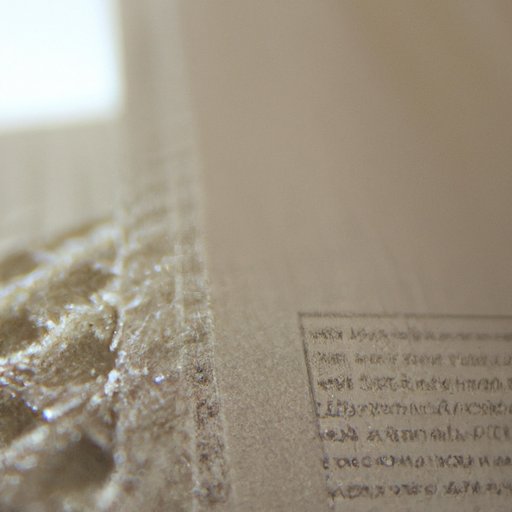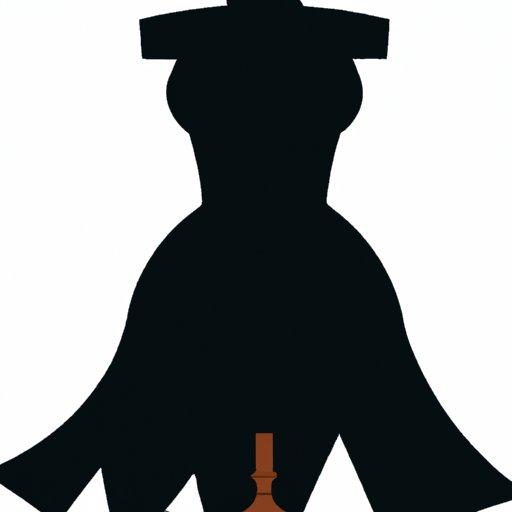Introduction
Describing a dress in writing can be a daunting task. It requires the writer to have a good understanding of fabrics, textures, cuts, shapes, silhouettes, colours, patterns, detailing, accessories, and occasions. To help you become more confident in your ability to accurately describe a dress in writing, this article will cover these topics in detail.

Describing the Fabric and Texture of the Dress
The fabric and texture of a dress are important components to consider when describing it in writing. Different types of fabrics can affect the look, feel, and durability of a dress, so it’s important to be aware of the different kinds of fabrics available and how they can impact the overall look of the dress.
Types of Fabrics
When describing a dress in writing, one should mention the type of fabric it is made from. Common fabric materials include cotton, silk, polyester, rayon, linen, wool, and spandex. Each of these fabrics has its own unique characteristics, such as breathability, drape, durability, and texture. For example, cotton is soft and lightweight, while silk is luxurious and often used for formal wear. Polyester is wrinkle-resistant and holds its shape well, while rayon adds a bit of stretchiness and is often used for casual wear.
Textures of the Dress
In addition to mentioning the type of fabric a dress is made from, it’s also important to consider the texture of the fabric. Textures can range from smooth and silky to rough and nubby. A dress with a smooth texture may appear sleek and elegant, while a dress with a rougher texture may appear more casual and relaxed. The texture of the fabric is an important factor to consider when describing a dress in writing.
Providing an Overall Description of the Dress’s Cut, Shape, and Silhouette
The cut, shape, and silhouette of a dress all contribute to its overall appearance. When describing a dress in writing, it’s important to take note of these elements and provide an accurate description of them.
Types of Cuts
The cut of a dress refers to the way it is constructed. Common cuts include straight, A-line, sheath, empire, and wrap. A straight cut is a simple, straight-lined design with no curves or details. An A-line cut is slightly flared at the bottom, creating an A-shape silhouette. A sheath dress is form-fitting and hugs the body, while an empire cut is high-waisted with a full skirt. Lastly, a wrap dress wraps around the body and ties at the waist.
Different Shapes of Dresses
In addition to the cut of a dress, its shape is also important to consider. Common shapes of dresses include hourglass, pear, apple, and column. An hourglass-shaped dress has a fitted bodice and a flared skirt, while a pear-shaped dress is narrow at the top and fuller at the bottom. An apple-shaped dress is fitted at the waist and fuller through the hips and bust, and a column dress is long and slender with minimal shaping.
Common Silhouettes
The silhouette of a dress refers to the overall outline or contour of the garment. Common silhouettes include ball gown, mermaid, trumpet, and sheath. A ball gown has a full, voluminous skirt, while a mermaid dress is fitted through the torso and flares out at the knees. A trumpet dress is fitted through the bodice and flares out at the hips, and a sheath dress is form-fitting and hugs the body.
Describing the Colour, Pattern, and Detailing of the Dress
Colours, patterns, and detailing can all add to the overall aesthetic of a dress. When describing a dress in writing, it’s important to pay attention to these elements and provide an accurate description.
Colours
The colour of a dress is an important factor to consider when describing it. Common colours include black, white, red, blue, green, yellow, and pink. When describing the colour of a dress, be sure to mention the exact hue, as well as any other additional colours or shades that may be present. For example, a dress may be described as “a deep navy blue with a hint of purple”.
Patterns
Patterns can also be an important element to consider when describing a dress. Common patterns include stripes, polka dots, floral, and animal print. When describing the pattern of a dress, be sure to mention the exact pattern, as well as any additional colours or shades that may be present. For example, a dress may be described as “a white and grey striped pattern with a hint of pink”.
Detailing
Detailing such as ruffles, lace, embroidery, and beading can add a unique touch to a dress. When describing the detailing of a dress, be sure to mention the type of detailing, as well as any additional colours or shades that may be present. For example, a dress may be described as “embroidered with gold thread and adorned with pearls”.

Talking About Accessories that Accompany the Dress
Accessories are an important component to consider when describing a dress. Accessories can range from shoes and handbags to jewellery and hats. When describing accessories, be sure to mention the type of accessory, as well as any additional colours or shades that may be present. For example, a dress may be described as “paired with black stilettos and a silver clutch bag”.
Types of Accessories
When describing a dress in writing, it’s important to mention the types of accessories that accompany it. Common accessories include shoes, handbags, jewellery, hats, and scarves. Each type of accessory has its own unique characteristics, such as style, colour, and material. For example, shoes can range from sandals to boots, and handbags can range from clutches to totes.
How to Choose the Right Accessories
When choosing accessories to accompany a dress, it’s important to consider the style, colour, and material of the dress. The accessories should complement the dress, not overpower it. It’s also important to consider the occasion for which the dress is being worn. For example, a formal event might call for more elegant accessories, such as diamond earrings and a velvet clutch, while a casual event might call for more relaxed accessories, such as a straw hat and a canvas tote.
Describing the Fit of the Dress on the Body
The fit of a dress is an important factor to consider when describing it in writing. It’s important to provide an accurate description of how the dress fits on the body, as this can have an impact on the overall look and feel of the dress.
Measurements Needed to Determine Fit
When describing the fit of a dress, it’s important to provide measurements. Common measurements to consider include chest, waist, hip, and length. Chest measurements refer to the circumference of the chest, waist measurements refer to the circumference of the waist, hip measurements refer to the circumference of the hips, and length measurements refer to the length of the dress from shoulder to hem.
Tips for Finding the Right Fit
When choosing a dress, it’s important to try on several different sizes and styles to find the right fit. Be sure to check the size chart provided by the manufacturer to ensure the dress is the correct size. Additionally, consider the type of fabric the dress is made from and how it will affect the fit. For example, a dress made from a lightweight fabric may fit differently than a dress made from a heavier fabric.

Discussing the Occasion for Which the Dress is Appropriate
The occasion for which a dress is appropriate is an important factor to consider when describing it in writing. Different occasions call for different types of dresses, so it’s important to mention the type of occasion for which the dress is suitable.
Formal Events
Formal events such as weddings, galas, and black tie affairs typically call for more formal attire, such as floor-length gowns and cocktail dresses. When describing a dress for a formal event, be sure to mention the type of occasion, as well as any additional details that may be relevant. For example, a dress may be described as “a floor-length gown with an empire waist, perfect for a black tie affair”.
Casual and Semi-Formal Events
Casual and semi-formal events such as dinner parties, office parties, and holiday gatherings typically call for less formal attire, such as cocktail dresses, jumpsuits, and skirts. When describing a dress for a casual or semi-formal event, be sure to mention the type of occasion, as well as any additional details that may be relevant. For example, a dress may be described as “a sleeveless cocktail dress with a lace overlay, perfect for an office party”.
Conclusion
In conclusion, describing a dress in writing can be a challenging task. It requires the writer to have a good understanding of fabrics, textures, cuts, shapes, silhouettes, colours, patterns, detailing, accessories, and occasions. This article has provided an overview of how to describe a dress in writing, including the fabric and texture of the dress, its overall cut, shape and silhouette, its colour, pattern and detailing, the accessories that accompany it, the fit of the dress on the body, and the type of occasion for which it is appropriate.
Summary of Key Points
When describing a dress in writing, it’s important to consider the fabric and texture of the dress, its overall cut, shape and silhouette, its colour, pattern and detailing, the accessories that accompany it, the fit of the dress on the body, and the type of occasion for which it is appropriate.
Final Thoughts
By following the tips outlined in this article, you can become more confident in your ability to accurately describe a dress in writing. With practice, you will be able to provide detailed and accurate descriptions of dresses that will help readers visualize the garment in their minds.
(Note: Is this article not meeting your expectations? Do you have knowledge or insights to share? Unlock new opportunities and expand your reach by joining our authors team. Click Registration to join us and share your expertise with our readers.)
